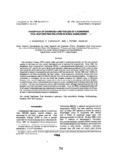Perception of Diarrhoea and the use of a homemade oral rehydration solution in rural Bangladesh
Date
1988Publisher
International Centre for Diarrhoeal Disease Research, BangladeshMetadata
Show full item recordCitation
Chowdhury, A., & Vaughan, J. P. (1988). Perception of Diarrhoea and the use of a homemade oral rehydration solution in rural Bangladesh. AMR Chowdhury Publications Volume I: 1978-199, 74–82.Abstract
Oral rehydration therapy (ORT) is being widely promoted in developing countries but the socio-cultural aspects of diarrhea are often poorly investigated prior to planning the programs. Since 1980 the Bangladesh Rural Advancement Committee (BRAC) a non-governmental organization has promoted a home-made ORT solution for use in all diarrhea episodes called lobon-gur solution (LGS) which is made from household lobon (salt) and gur (unrefined sugar) using the pinch-and-scoop method. 1 mother per household is trained in its preparation and use during a half-hour visit. By late 1986 over 7 million of Bangladeshs 16 million households had been visited. Initial program monitoring showed that most mothers could prepare a safe and effective solution but that its use was less encouraging. A village study undertaken to investigate this low use found that villagers recognize 4 different types of diarrhea illnesses: 1) dud haga due to breast-milk in infants; 2) ajirno due to over-eating or bad food; 3) amasa a mucoid diarrhea with or without blood and and of unknown cause; and 4) daeria which is severe watery diarrhea or cholera. LGS was most frequent used for daeria episodes which although representing only 5% of all episodes are those most likely to lead to dehydration and death. Thus the BRAC message promoting LGS for all types of watery diarrhea was understood by the people to be of most use for severe watery diarrhea. The importance of this local classification of diarrhea has only just received recognition despite more than 25 years of diarrheal disease research in Bangladesh.

